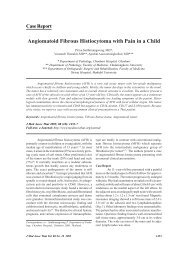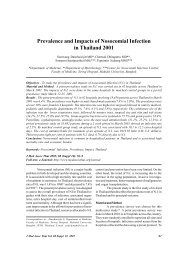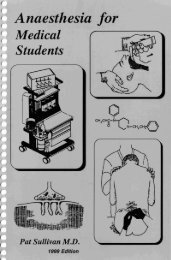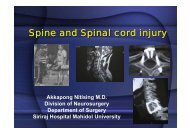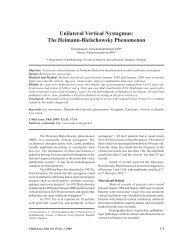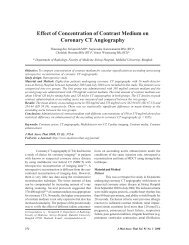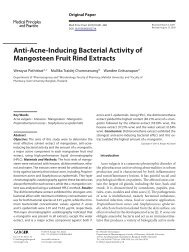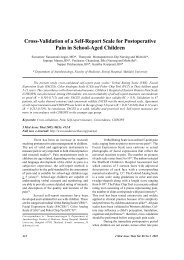CAT/CLAMS - Mahidol University
CAT/CLAMS - Mahidol University
CAT/CLAMS - Mahidol University
Create successful ePaper yourself
Turn your PDF publications into a flip-book with our unique Google optimized e-Paper software.
Developmental Screening by the Cognitive Adaptive<br />
Test/Clinical Linguistic and Auditory Milestone Scale<br />
(<strong>CAT</strong>/<strong>CLAMS</strong>) in HIV- Infected Children<br />
J Med Assoc Thai 2005; 88(Suppl 8): S211-4<br />
Full text. e-Journal: http://www.medassocthai.org/journal<br />
Correspondence to: Nirun Vanprapar MD, Department of<br />
Pediatrics, Faculty of Medicine Siriraj Hospital, 2 Prannok Rd.,<br />
Bangkok-noi, Bangkok 10700, Thailand Tel: 661-824-5466<br />
Fax: 662-418-0544 E-mail: sinvp@mahidol.ac.th<br />
Nirun Vanprapar MD*, Nantaka Kongstan RN, MSc*,<br />
Pisit Tritilanant RA*, Uraporn Kottapat MSc*,<br />
Yuitiang Durier MEd*, Samrauy Tritilanant MD*<br />
*Department of Pediatrics, Faculty of Medicine Siriraj Hospital, <strong>Mahidol</strong> <strong>University</strong>, Bangkok, Thailand<br />
Bayley Scales of Infant Development (BSID) is considered to be a standard test for child development.<br />
The test requires experienced evaluator and is time consuming; therefore, it is not easy to apply in busy clinic.<br />
The Cognitive Adaptive Test/Clinical Linguistic and Auditory Milestone Scale (<strong>CAT</strong>/<strong>CLAMS</strong>) is an easy<br />
assessment method that has been demonstrated to correlate with BSID in many studies among normal and<br />
developmental delayed children, including in HIV-infected infants. We created a pilot system of <strong>CAT</strong>/<strong>CLAMS</strong><br />
assessment applied to 16 HIV-infected infants ages 12-34 months. They were all in the normal range score of<br />
developmental quotient (DQ). However, longitudinal follow-up by <strong>CAT</strong>/<strong>CLAMS</strong> assessment is needed in<br />
these HIV-infected children. When DQ score is below 70 (assuming to be delayed development), the child<br />
should be evaluated by BSID. In this way delayed development can be screened easily and early developmental<br />
stimulation program can be implemented appropriately.<br />
Keywords: HIV-infected children, Developmental screening, <strong>CAT</strong>/<strong>CLAMS</strong>, BSID<br />
HIV virus is a lymphotropic and neurotropic<br />
virus. Delayed in neurodevelopmental milestones can<br />
be the first presenting symptom (1-2) . Symptoms varied<br />
from mild, such as abnormal muscle tone to severe,<br />
such as progressive developmental delay or loss of<br />
previously acquired milestone. These symptoms could<br />
be detected as early as 6 month of age (3) .<br />
The Bayley Scales of Infant Development<br />
(BSID) are the frequently used assessment method to<br />
evaluate neurodevelopment in infants and young children.<br />
However, the test is time consuming (30-45 minute<br />
administration time) and requires experienced personnel<br />
to apply and interpret. These make the test unable<br />
to implement routinely in general practice.<br />
The Cognitive Adaptive Test / Clinical Linguistic<br />
and Auditory Milestone Scale (<strong>CAT</strong>/<strong>CLAMS</strong>)<br />
was designed for use by primary pediatric health care<br />
providers to screen children for cognitive delay using<br />
minimal equipment in shorter time (usually 15-20 minutes)<br />
(4) . Correlation between <strong>CAT</strong>/<strong>CLAMS</strong> and BSID<br />
has been demonstrated in normal children as well as<br />
high risk groups of developmental delayed children<br />
between 1 to 36 months of age (5-6) .<br />
This study aimed to evaluate <strong>CAT</strong>/<strong>CLAMS</strong><br />
as a screening tool for detection of developmental<br />
problem HIV-infected children in our HIV clinic. The<br />
patients with abnormal <strong>CAT</strong>/<strong>CLAMS</strong> assessment were<br />
then confirmed by BSID and were treated appropriately.<br />
Material and Method<br />
We initiated neurodevelopmental assessment<br />
program using <strong>CAT</strong>/<strong>CLAMS</strong> in HIV-infected children<br />
who were followed at Siriraj Hospital, Bangkok.<br />
HIV infected children, diagnosed by either two<br />
positive DNA PCR at any time or positive HIV anti-<br />
J Med Assoc Thai Vol. 88 Suppl. 8 2005 S211
ody after 18 months of age were enrolled. At the time<br />
of assessment, subjects did not have any acute illness<br />
and visited the clinic for antiretroviral therapy. The <strong>CAT</strong>/<br />
<strong>CLAMS</strong> assessment was applied by either one of the<br />
investigators (PT or NK).<br />
<strong>CAT</strong>/<strong>CLAMS</strong> is a 100-item scale administered<br />
in two parts and is obtained through observation. <strong>CAT</strong><br />
consists of visual-motor problem solving items performed<br />
directly with the child. <strong>CLAMS</strong> items consist of<br />
language acquisition. The test is performed in sequential<br />
fashion until the basal age is reached, i.e, when two<br />
consecutive months of items were all scored positive.<br />
Items would continue to be presented to the patient<br />
until the items of the next two consecutive months of<br />
were all unable to attain. This report is the result of<br />
one-time cross-sectional assessment.<br />
Scoring:-<br />
Developmental quotient on visual motor problem<br />
solving (<strong>CAT</strong> DQ) is <strong>CAT</strong> age divided by chronological<br />
age, then multiplied by 100. Developmental quotient<br />
in language (<strong>CLAMS</strong> DQ) is <strong>CLAMS</strong> age divided<br />
by chronological age, then multiplied by 100. <strong>CAT</strong>/<br />
<strong>CLAMS</strong>-r developmental quotient is the arithmetic mean<br />
of <strong>CAT</strong> DQ and <strong>CLAMS</strong> DQ.<br />
Table 1. DQ of <strong>CAT</strong>, <strong>CLAMS</strong> and <strong>CAT</strong>/<strong>CLAMS</strong>-r of 16 HIV infected children<br />
S212<br />
Gender<br />
M<br />
F<br />
Chronological<br />
Age (Month)<br />
12*<br />
14<br />
16<br />
18<br />
18<br />
20<br />
20<br />
32<br />
13*<br />
19<br />
19<br />
19*<br />
27<br />
28<br />
32<br />
34<br />
<strong>CAT</strong><br />
Basal age DQ<br />
10.3<br />
14.0<br />
17.0<br />
20.0<br />
20.0<br />
20.0<br />
17.0<br />
30.0<br />
16.2<br />
19.0<br />
21.7<br />
20.4<br />
27.0<br />
26.3<br />
34.5<br />
27.0<br />
* Discrepancies between <strong>CAT</strong>-<strong>CLAMS</strong> DQ > 10<br />
Interpretation: -<br />
The DQ of 85 to 120 is normal; 70 to 85 is<br />
borderline; under 70 is delayed. Discrepancies between<br />
<strong>CAT</strong> DQ and <strong>CLAMS</strong> DQ may be seen in communicative<br />
disordered child.<br />
Results<br />
Sixteen HIV infected children were assessed.<br />
Their age range was between 12 to 34 months. Eight<br />
patients were male (13-34 months old) and eight were<br />
female (12-32 months old). Most of the males (5 of 8)<br />
were younger than 19 months of age while seven of<br />
eight females were older than 19 months of age. The<br />
<strong>CAT</strong>/<strong>CLAMS</strong> was successfully performed in every<br />
child and finished within 15-20 minutes. The DQ score<br />
of <strong>CAT</strong> <strong>CLAMS</strong> and <strong>CAT</strong> /<strong>CLAMS</strong>-r were displayed in<br />
Table 1. All except one child had DQ score less than 85.<br />
There were 3 children who had <strong>CAT</strong> DQ and <strong>CLAMS</strong><br />
DQ difference of > 10.<br />
85.8<br />
100.0<br />
106.2<br />
111.1<br />
111.1<br />
100.0<br />
85.0<br />
93.7<br />
124.6<br />
100.0<br />
114.2<br />
107.3<br />
100.0<br />
93.9<br />
107.8<br />
79.4<br />
Discussion<br />
<strong>CAT</strong>/<strong>CLAMS</strong> assessment is an easy and<br />
feasible test for general practitioners. Personnel can<br />
be trained to perform the test within 2-3 hours. <strong>CAT</strong>/<br />
<strong>CLAMS</strong> assessment has 66-88 % sensitivity and<br />
<strong>CLAMS</strong><br />
Basal age DQ<br />
11.5<br />
14.0<br />
17.0<br />
18.5<br />
17.0<br />
18.5<br />
17.0<br />
28.5<br />
13.0<br />
18.0<br />
21.0<br />
17.0<br />
25.5<br />
30.0<br />
36.0<br />
26.0<br />
95.8<br />
100.0<br />
106.2<br />
102.8<br />
94.4<br />
92.5<br />
85.0<br />
89.0<br />
100.0<br />
94.7<br />
110.5<br />
89.4<br />
94.4<br />
107.1<br />
112.5<br />
76.4<br />
<strong>CAT</strong>/<strong>CLAMS</strong>-r<br />
DQ<br />
90.8<br />
100.0<br />
106.2<br />
106.9<br />
102.8<br />
96.2<br />
85.0<br />
91.4<br />
112.3<br />
97.3<br />
112.3<br />
98.4<br />
97.2<br />
100.5<br />
110.5<br />
77.9<br />
J Med Assoc Thai Vol. 88 Suppl. 8 2005
67-85% specificity (7-9) when compared with BSID, with<br />
the cut-off score below 70 for developmental delayed.<br />
The prevalence of neurodevelopmental manifestations<br />
of HIV infection has been reported in several series to<br />
vary between 8% and 62% (10) . From this study, we<br />
found only 1 of 17 children that had score
°“√π” <strong>CAT</strong>/<strong>CLAMS</strong> ¡“µ√«®§—¥°√ÕßÀ“¿“«–æ—≤π“°“√≈à“â“„πºŸâªÉ«¬‡¥Á°∑’<br />
˵‘¥‡◊ÈÕ<br />
HIV<br />
π‘√—π¥√å «√√≥ª√–¿“, π—π∑°“ °Õß ∂“π, æ‘ ‘∞ ‰µ√µ‘≈“π—π∑å, Õÿ√“æ√ ‚§µ√æ—≤πå, ¬ÿ⬇µ’¬ß<br />
¥Ÿ√‘‡¬√å,<br />
”√«¬ ‰µ√µ‘≈“π—π∑å<br />
Bayley Scales of Infant Development (BSID) ‡ªìπ‡§√◊ËÕß¡◊Õ∑’ˬա√—∫„π°“√ª√–‡¡‘π¥Ÿ¿“«–°“√≥å<br />
æ—≤π“°“√â“¢Õ߇¥Á°‡≈Á°∑’ˉ¥â¡“µ√∞“π ·µà‡æ√“–µâÕßÕ“»—¬ºŸâ‡’ˬ«“≠∑’˺à“π°“√Õ∫√¡ ·≈–‡ ’¬‡«≈“„π°“√<br />
ª√–‡¡‘ππ“𠧫√µâÕß¡’°“√µ√«®§—¥°√Õ߇æ◊ËÕ‡≈◊Õ°‡©æ“–ºŸâªÉ«¬∑’Ëπà“®–¡’ªí≠À“ °àÕπ¡“∑”°“√ª√–‡¡‘π¥â«¬ BSID.<br />
The Cognitive Adaptive Test/Clinical Linguistic and Auditory Milestone Scale (<strong>CAT</strong>/<strong>CLAMS</strong>) ‡ªìπ‡§√◊ËÕß¡◊Õ<br />
§—¥°√Õß¿“«–¥—ß°≈à“«∑’ˉ¡àµâÕßÕ“»—¬ºŸâ‡’ˬ«“≠¢π“¥π—Èπ ·≈–‡«≈“∑’Ë„âª√–‡¡‘π —Èπ°«à“ ®÷߉¥â¡’°“√π”¡“‡√‘Ë¡„â<br />
°—∫ºŸâªÉ«¬‡¥Á°µ‘¥‡◊ÈÕ‚√§¿Ÿ¡‘§ÿâ¡°—π∫°æ√àÕß (HIV) ∑’Ë¡“√—∫°“√√—°…“∑’˧≈‘π‘°‡©æ“–‚√§¿“§«‘“°ÿ¡“√‡«»“ µ√å<br />
‚√ß欓∫“≈»‘√‘√“ º≈°“√µ√«®‡¥Á°µ‘¥‡◊ÈÕ‚√§¿Ÿ¡‘§ÿâ¡°—π∫°æ√àÕß 16 √“¬ ¥â«¬ <strong>CAT</strong>/<strong>CLAMS</strong> æ∫«à“Õ¬Ÿà„π§–·ππ<br />
DQ ª°µ‘ ·µàµâÕß∑”°“√µ√«®µ‘¥µ“¡µàÕ‰ª¥â«¬°“√∑” <strong>CAT</strong>/<strong>CLAMS</strong> ‡ªìπ√–¬– ·≈–∂â“æ∫º‘¥ª°µ‘ §◊յ˔°«à“ DQ<br />
score 70 §«√ àßµ√«® BSID ‡æ◊ËÕ¬◊π¬—π ‚¥¬«‘∏’π’È®– “¡“√∂µ√«®æ∫‡¥Á°∑’Ë¡’æ—≤π“°“√≈à“Ⓣ¥â√«¥‡√Á«Õ¬à“ßßà“¬¥“¬<br />
‡æ◊ËÕ®– à߇¢â“‚ª√·°√¡°“√°√–µÿâπæ—≤π“°“√µàÕ‰ª<br />
S214<br />
J Med Assoc Thai Vol. 88 Suppl. 8 2005



